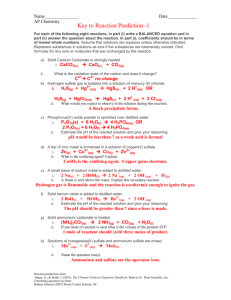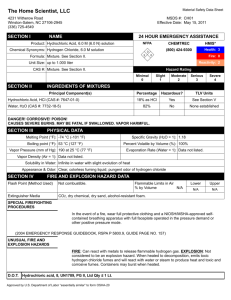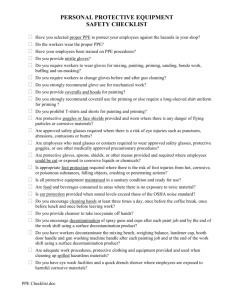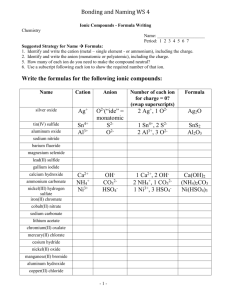Common Name Manufactured by CAS Number
advertisement
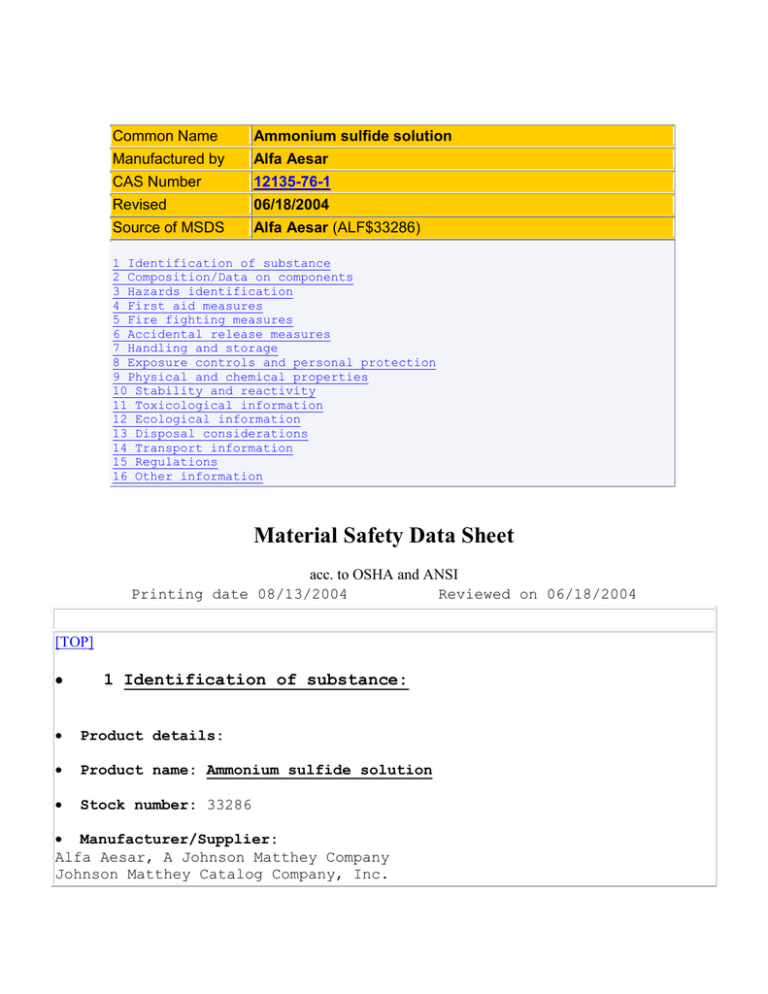
Common Name Ammonium sulfide solution Manufactured by Alfa Aesar CAS Number 12135-76-1 Revised 06/18/2004 Source of MSDS Alfa Aesar (ALF$33286) 1 Identification of substance 2 Composition/Data on components 3 Hazards identification 4 First aid measures 5 Fire fighting measures 6 Accidental release measures 7 Handling and storage 8 Exposure controls and personal protection 9 Physical and chemical properties 10 Stability and reactivity 11 Toxicological information 12 Ecological information 13 Disposal considerations 14 Transport information 15 Regulations 16 Other information Material Safety Data Sheet acc. to OSHA and ANSI Printing date 08/13/2004 Reviewed on 06/18/2004 [TOP] 1 Identification of substance: Product details: Product name: Ammonium sulfide solution Stock number: 33286 Manufacturer/Supplier: Alfa Aesar, A Johnson Matthey Company Johnson Matthey Catalog Company, Inc. 30 Bond Street Ward Hill, MA 01835-8099 Emergency Phone: (978) 521-6300 CHEMTREC: (800) 424-9300 Web Site: www.alfa.com Information Department: Health, Safety and Environmental Department Emergency information: During normal hours the Health, Safety and Environmental Department. After normal hours call Chemtrec at (800) 424-9300. [TOP] 2 Composition/Data on components: Chemical characterization: Description: (CAS#) Ammonium sulfide (CAS# 12135-76-1), 20-24% Water (CAS# 7732-18-5), 76-80% Identification number(s): EINECS Number: 235-223-4 [TOP] 3 Hazards identification Hazard description: C Corrosive Information pertaining to particular dangers for man and environment R 31 Contact with acids liberates toxic gas. R 34 Causes burns. Classification system HMIS ratings (scale 0-4) (Hazardous Materials Identification System) Health (acute effects) = 3 Flammability = 3 Reactivity = 2 [TOP] 4 First aid measures General information Immediately remove any clothing soiled by the product. After inhalation Supply fresh air. If required, provide artificial respiration. Keep patient warm. Seek immediate medical advice. After skin contact Immediately wash with water and soap and rinse thoroughly. Seek immediate medical advice. After eye contact Rinse opened eye for several minutes under running water. Then consult a doctor. After swallowing Seek immediate medical advice. [TOP] 5 Fire fighting measures Suitable extinguishing agents Water haze Alcohol resistant foam Dry sand For safety reasons unsuitable extinguishing agents Carbon dioxide Special hazards caused by the material, its products of combustion or resulting gases: In case of fire, the following can be released: Nitrogen oxides (NOx) Sulfur dioxide (SO2) Ammonia Hydrogen sulfide Protective equipment: Wear self-contained respirator. Wear fully protective impervious suit. [TOP] 6 Accidental release measures Person-related safety precautions: Mount respiratory protective device. Measures for environmental protection: Do not allow material to be released to the environment without proper governmental permits. Measures for cleaning/collecting: Absorb with liquid-binding material (sand, diatomite, acid binders, universal binders, sawdust). Use neutralizing agent. Dispose contaminated material as waste according to item 13. Ensure adequate ventilation. Additional information: See Section 7 for information on safe handling See Section 8 for information on personal protection equipment. See Section 13 for disposal information. [TOP] 7 Handling and storage Handling Information for safe handling: Keep container tightly sealed. Store in cool, dry place in tightly closed containers. Ensure good ventilation at the workplace. Information about protection against explosions and fires: Keep ignition sources away. Protect from heat. Storage Requirements to be met by storerooms and receptacles: No special requirements. Information about storage in one common storage facility: Do not store together with acids. Do not store together with alkalies (caustic solutions). Aqueous solutions are incompatible with alkali and alkaline earth metals and many reactive organic and inorganic chemicals. Further information about storage conditions: Store under lock and key and with access restricted to technical experts or their assistants only. [TOP] 8 Exposure controls and personal protection Additional information about design of technical systems: Properly operating chemical fume hood designed for hazardous chemicals and having an average face velocity of at least 100 feet per minute. Components with limit values that require monitoring at the workplace: Not required. Additional information: No data Personal protective equipment General protective and hygienic measures The usual precautionary measures for handling chemicals should be followed. Keep away from foodstuffs, beverages and feed. Remove all soiled and contaminated clothing immediately. Wash hands before breaks and at the end of work. Avoid contact with the eyes and skin. Breathing equipment: Use suitable respirator when high concentrations are present. Protection of hands: Impervious gloves Eye protection: Safety glasses Tightly sealed goggles Full face protection Body protection: Protective work clothing. [TOP] 9 Physical and chemical properties: General Information Form: Liquid Color: Clear Yellow Odor: Like rotten eggs Change in condition Melting point/Melting range: Boiling point/Boiling range: Sublimation temperature / start: Value/Range Unit Not determined Not determined Not determined Flash point: Ignition temperature: Not determined Decomposition temperature: Not determined Danger of explosion: 60 ° C Method Product does not present an explosion hazard. Explosion limits: Lower: Upper: Vapor pressure: at 20 ° C 546 hPa Density: at 20 ° C 0.997 g/cm³ Solubility in / Miscibility with Water: Not determined Not determined Fully miscible [TOP] 10 Stability and reactivity Thermal decomposition / conditions to be avoided: Decomposition will not occur if used and stored according to specifications. Materials to be avoided: Acids Aluminum/aluminum alloys. Copper Aqueous solutions are incompatible with alkali and alkaline earth metals and many reactive organic and inorganic chemicals. Dangerous reactions Reacts with acids forming hydrogen sulfide Reacts with alkali metals Reacts with alkaline earth metals Reacts with strong oxidizing agents Dangerous products of decomposition: Hydrogen sulfide Sulfur oxides (SOx) Ammonia Nitrogen oxides (NOx) [TOP] 11 Toxicological information Acute toxicity: Primary irritant effect: on the skin: Corrosive effect on skin and mucous membranes. Irritant to skin and mucous membranes. on the eye: Strong corrosive effect. Irritating effect. Sensitization: No sensitizing effects known. Subacute to chronic toxicity: Corrosive materials are acutely destructive to the respiratory tract, eyes, skin and digestive tract. Eye contact may result in permanent damage and complete vision loss. Inhalation may result in respiratory effects such as inflammation, edema, and chemical pneumonitis. May cause coughing, wheezing, laryngitis, shortness of breath, headache, nausea and vomiting. Ingestion may cause damage to the mouth, throat and esophagus. May cause skin burns or irritation depending on the severity of the exposure. Sulfides show variable toxicity. The alkaline sulfides are similar in action to alkalies. They cause irritation of the skin and are corrosive by ingestion. The heavy metal sulfides are generally insoluble and show little toxic action except through the liberation of hydrogen sulfide. Hydrogen sulfide, if generated, is toxic, a severe irritant and flammable. Effects include conjunctivitis, headache, nausea, dizziness, coughing, pulmonary edema and possibly death. Additional toxicological information: Swallowing will lead to a strong corrosive effect on mouth and throat and to the danger of perforation of esophagus and stomach. To the best of our knowledge the acute and chronic toxicity of this substance is not fully known. No classification data on carcinogenic properties of this material is available from the EPA, IARC, NTP, OSHA or ACGIH. [TOP] 12 Ecological information: General notes: Do not allow material to be released to the environment without proper governmental permits. [TOP] 13 Disposal considerations Product: Recommendation Consult state, local or national regulations to ensure proper disposal. Uncleaned packagings: Recommendation: Disposal must be made according to official regulations. Recommended cleansing agent: Water, if necessary with cleansing agents. [TOP] 14 Transport information DOT regulations: Hazard class: 8 Identification number: UN2683 Packing group: II Hazardous substance: 100 lbs, 45.4 kg Proper shipping name (technical name): Ammonium sulphide solution Land transport ADR/RID ADR/RID class: Item: Danger code (Kemler): UN-Number: Description of goods: Maritime transport IMDG: IMDG Class: UN Number: Packaging group: Proper shipping name: Air transport ICAO-TI and IATA-DGR: ICAO/IATA Class: 8 UN/ID Number: 2683 Packaging group: II Proper shipping name: Ammonium sulphide solution [TOP] (cross-border) 8 Corrosive substances 45b2 86 2683 Ammonium sulphide solution 8 2683 II Ammonium sulphide solution 15 Regulations Product related hazard informations: Hazard symbols: C Corrosive Risk phrases: 31 Contact with acids liberates toxic gas. 34 Causes burns. Safety phrases: 26 In case of contact with eyes, rinse immediately with plenty of water and seek medical advice. 36/37/39 Wear suitable protective clothing, gloves and eye/face protection. 45 In case of accident or if you feel unwell, seek medical advice immediately. National regulations All components of this product are listed in the U.S. Environmental Protection Agency Toxic Substances Control Act Chemical substance Inventory. Information about limitation of use: For use only by technically qualified individuals. [TOP] 16 Other information: Employers should use this information only as a supplement to other information gathered by them, and should make independent judgement of suitability of this information to ensure proper use and protect the health and safety of employees. This information is furnished without warranty, and any use of the product not in conformance with this Material Safety Data Sheet, or in combination with any other product or process, is the responsibility of the user. Department issuing MSDS: Health, Safety and Environmental Department. Contact: Darrell R. Sanders


